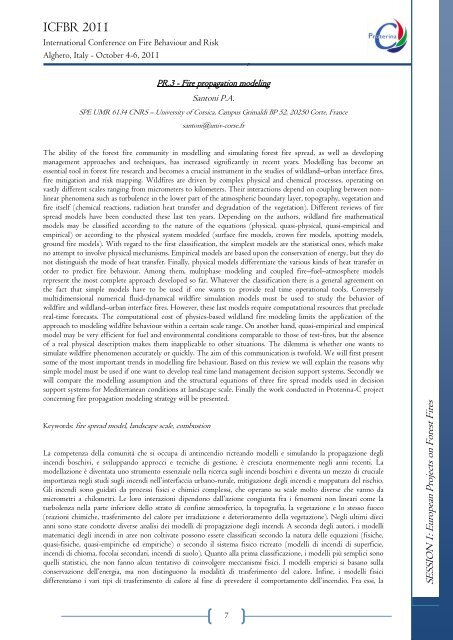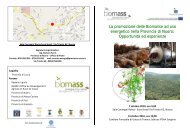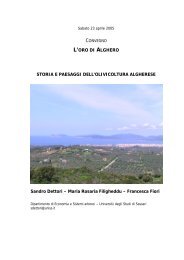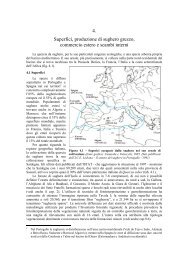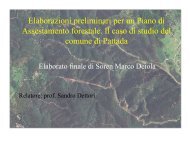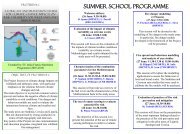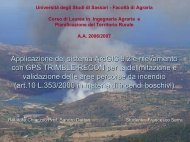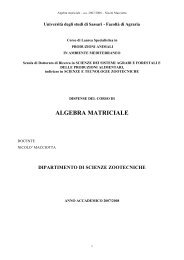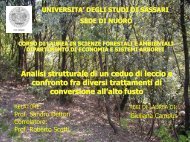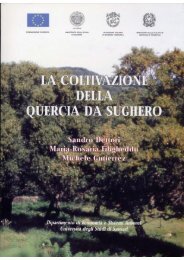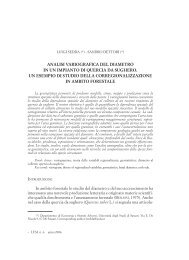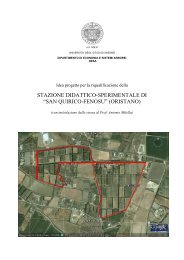BOOK degli ABSTRACT - Dipartimento di Economia e Sistemi ...
BOOK degli ABSTRACT - Dipartimento di Economia e Sistemi ...
BOOK degli ABSTRACT - Dipartimento di Economia e Sistemi ...
- No tags were found...
Create successful ePaper yourself
Turn your PDF publications into a flip-book with our unique Google optimized e-Paper software.
ICFBR 2011International Conference on Fire Behaviour and RiskAlghero, Italy - October 4-6, 2011PR.3 - Fire propagation modelingSantoni P.A.SPE UMR 6134 CNRS – University of Corsica, Campus Grimal<strong>di</strong> BP 52, 20250 Corte, Francesantoni@univ-corse.frThe ability of the forest fire community in modelling and simulating forest fire spread, as well as developingmanagement approaches and techniques, has increased significantly in recent years. Modelling has become anessential tool in forest fire research and becomes a crucial instrument in the stu<strong>di</strong>es of wildland–urban interface fires,fire mitigation and risk mapping. Wildfires are driven by complex physical and chemical processes, operating onvastly <strong>di</strong>fferent scales ranging from micrometers to kilometers. Their interactions depend on coupling between nonlinearphenomena such as turbulence in the lower part of the atmospheric boundary layer, topography, vegetation andfire itself (chemical reactions, ra<strong>di</strong>ation heat transfer and degradation of the vegetation). Different reviews of firespread models have been conducted these last ten years. Depen<strong>di</strong>ng on the authors, wildland fire mathematicalmodels may be classified accor<strong>di</strong>ng to the nature of the equations (physical, quasi-physical, quasi-empirical andempirical) or accor<strong>di</strong>ng to the physical system modeled (surface fire models, crown fire models, spotting models,ground fire models). With regard to the first classification, the simplest models are the statistical ones, which makeno attempt to involve physical mechanisms. Empirical models are based upon the conservation of energy, but they donot <strong>di</strong>stinguish the mode of heat transfer. Finally, physical models <strong>di</strong>fferentiate the various kinds of heat transfer inorder to pre<strong>di</strong>ct fire behaviour. Among them, multiphase modeling and coupled fire–fuel–atmosphere modelsrepresent the most complete approach developed so far. Whatever the classification there is a general agreement onthe fact that simple models have to be used if one wants to provide real time operational tools. Converselymulti<strong>di</strong>mensional numerical fluid-dynamical wildfire simulation models must be used to study the behavior ofwildfire and wildland–urban interface fires. However, these last models require computational resources that precludereal-time forecasts. The computational cost of physics-based wildland fire modeling limits the application of theapproach to modeling wildfire behaviour within a certain scale range. On another hand, quasi-empirical and empiricalmodel may be very efficient for fuel and environmental con<strong>di</strong>tions comparable to those of test-fires, but the absenceof a real physical description makes them inapplicable to other situations. The <strong>di</strong>lemma is whether one wants tosimulate wildfire phenomenon accurately or quickly. The aim of this communication is twofold. We will first presentsome of the most important trends in modelling fire behaviour. Based on this review we will explain the reasons whysimple model must be used if one want to develop real time land management decision support systems. Secondly wewill compare the modelling assumption and the structural equations of three fire spread models used in decisionsupport systems for Me<strong>di</strong>terranean con<strong>di</strong>tions at landscape scale. Finally the work conducted in Proterina-C projectconcerning fire propagation modeling strategy will be presented.Keywords: fire spread model, landscape scale, combustionLa competenza della comunità che si occupa <strong>di</strong> antincen<strong>di</strong>o ricreando modelli e simulando la propagazione <strong>degli</strong>incen<strong>di</strong> boschivi, e sviluppando approcci e tecniche <strong>di</strong> gestione, è cresciuta enormemente negli anni recenti. Lamodellazione è <strong>di</strong>ventata uno strumento essenziale nella ricerca sugli incen<strong>di</strong> boschivi e <strong>di</strong>venta un mezzo <strong>di</strong> crucialeimportanza negli stu<strong>di</strong> sugli incen<strong>di</strong> nell‘interfaccia urbano-rurale, mitigazione <strong>degli</strong> incen<strong>di</strong> e mappatura del rischio.Gli incen<strong>di</strong> sono guidati da processi fisici e chimici complessi, che operano su scale molto <strong>di</strong>verse che vanno damicrometri a chilometri. Le loro interazioni <strong>di</strong>pendono dall‘azione congiunta fra i fenomeni non lineari come laturbolenza nella parte inferiore dello strato <strong>di</strong> confine atmosferico, la topografia, la vegetazione e lo stesso fuoco(reazioni chimiche, trasferimento del calore per irra<strong>di</strong>azione e deterioramento della vegetazione). Negli ultimi <strong>di</strong>ecianni sono state condotte <strong>di</strong>verse analisi dei modelli <strong>di</strong> propagazione <strong>degli</strong> incen<strong>di</strong>. A seconda <strong>degli</strong> autori, i modellimatematici <strong>degli</strong> incen<strong>di</strong> in aree non coltivate possono essere classificati secondo la natura delle equazioni (fisiche,quasi-fisiche, quasi-empiriche ed empiriche) o secondo il sistema fisico ricreato (modelli <strong>di</strong> incen<strong>di</strong> <strong>di</strong> superficie,incen<strong>di</strong> <strong>di</strong> chioma, focolai secondari, incen<strong>di</strong> <strong>di</strong> suolo). Quanto alla prima classificazione, i modelli più semplici sonoquelli statistici, che non fanno alcun tentativo <strong>di</strong> coinvolgere meccanismi fisici. I modelli empirici si basano sullaconservazione dell‘energia, ma non <strong>di</strong>stinguono la modalità <strong>di</strong> trasferimento del calore. Infine, i modelli fisici<strong>di</strong>fferenziano i vari tipi <strong>di</strong> trasferimento <strong>di</strong> calore al fine <strong>di</strong> prevedere il comportamento dell‘incen<strong>di</strong>o. Fra essi, laSESSION 1: European Projects on Forest Fires7


